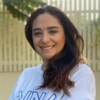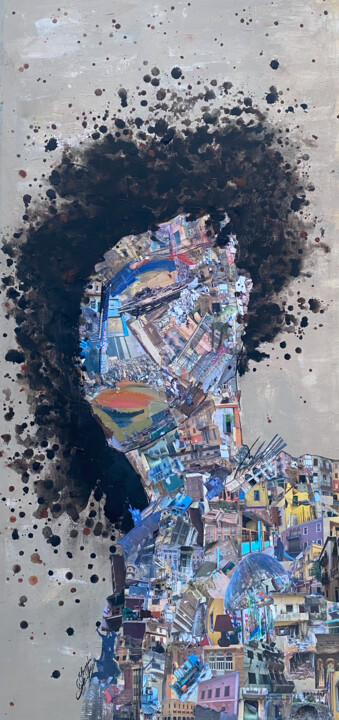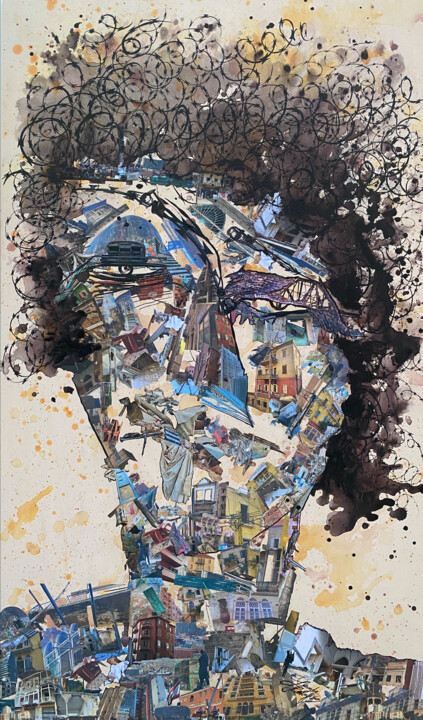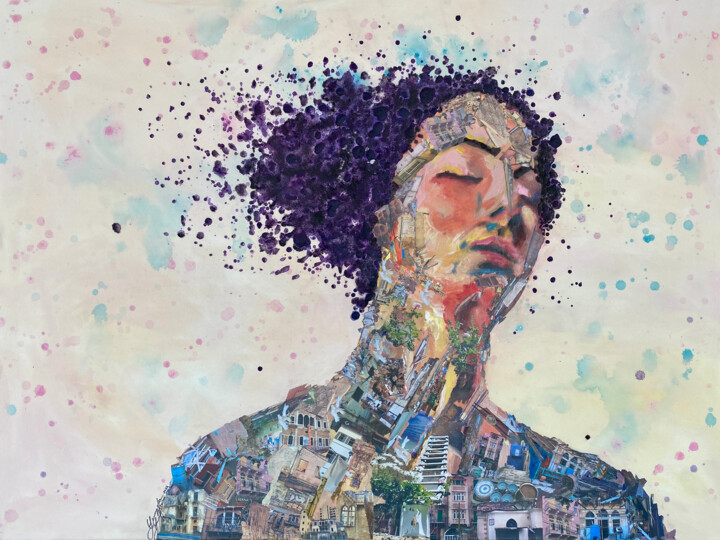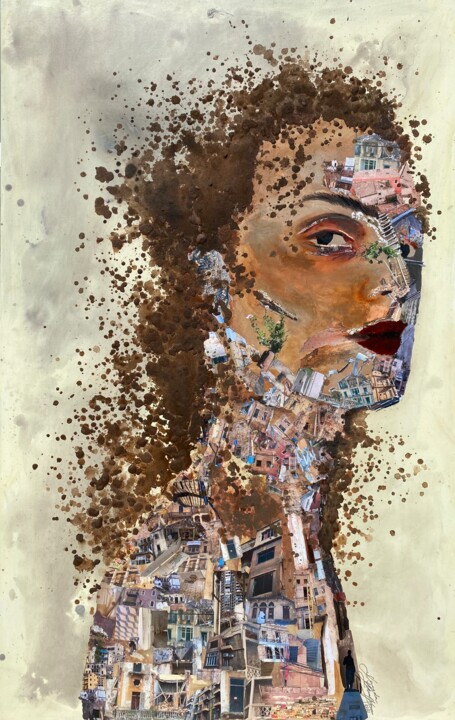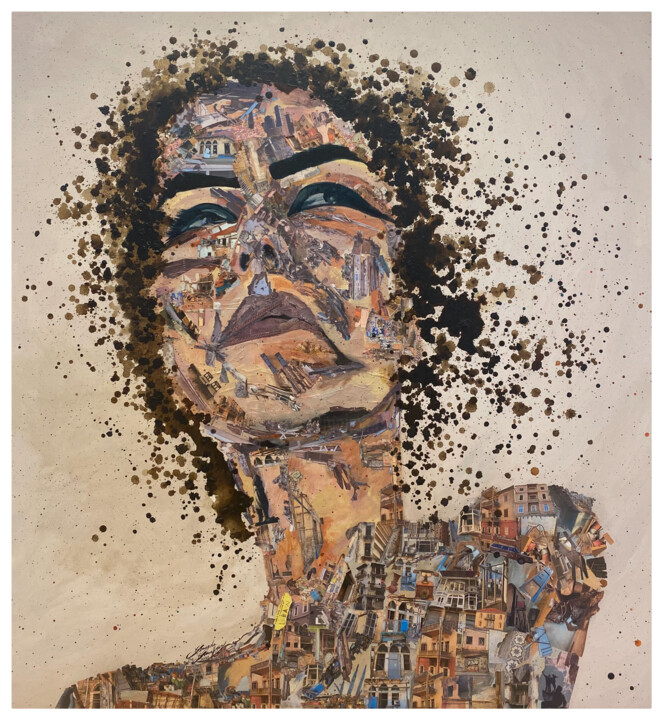What made you approach art and become an artist? (events, feelings, experiences...)
Art has always been a passion of mine; it came naturally to me, and I can’t help but create something. I find peace when I paint, and it is a natural way of communicating my thoughts and feelings. Words don’t come to me that easily. I always had questions about our human condition and how we interact to one another and through art I was able to channel those thoughts and go deeper in my search and reach a kind of inner consciousness which I can’t live without.
What is your artistic journey, techniques and subjects you have experimented with to date?
My work explores the psychology behind the conflicts and the bonds one creates with the places, events and faces encountered while in displacement. I was always fascinated by the endless oscillation of the human condition, from what makes us who we are and the psychology behind each moment of encounter and their impact on how we exchange on a sociological and environmental level with one another as individuals or collectively as a nation. While my earlier drawings were portraits, I ventured also into abstract because I like to experiment with textures and material to create forms and paint with. I believe that each material has a different energy on its own that can be transformed. My oil abstract series 2005 of paintings explores the triggers of change and what pushes us to take this step and have the courage to cross that door. Only when we cross that door can we know what it reveals. They are inspired by the darkness of the forest where only a ray of light can be seen between the leaves.
In 2015, I started exploring the idea of inclusion. This series is inspired by travel and mixing with other cultures. The more we see other cultures the more we find similarities and contrasts and enrich our life with so many humbling experiences. We learn tolerance and forgiveness and seeking to see the good in every moment. They are mixed media painting done using different types of paper, tissue, carboard and magazines and acrylic paint to achieve this beautiful mix of different material that behave differently but can form together harmony.
My recent works (2020-2021) have been concentrated on Beirut as it appears through abstract portraits of a strong, restless, unbeatable female, who despite the many falls, continues to rise and stand strong again. They are mixed media portraits done with collage of painstakingly organized pictures of the historical destroyed buildings of the city that forms the portraits and clearly expresses the accumulation of pain from decades of historical conflicts that made us who we are today. The journeys we take and the history we carry makes us who we are today.
A subject that had me going back to my Lebanese roots to be addressed by our very own poet and artist Khalil Gebran:
“Out of suffering have emerged the strongest souls; the most massive characters are seared with scars”
The second series (2021-2022) focuses more on the lessons we learn and the journeys we had to take in and away from home that exposes us to our past and to what the future could have been. It is a call to embrace our past and our roots and long for a better future. Inspired by the poet and artist Khalil Gebran:
“I have learned silence from the talkative, tolerance from the intolerant, and kindness from the unkind; yet strange, I am ungrateful to those teachers.”
Portraits of the women celebrating what makes us who we are, the journey we've come to travel that brings us for the longing for Hope, Ambition, Justice, Resilience, Solidarity, Resurrection, Tolerance, Freedom and Peace. These powerful words making the titles of the city’s portraits. (All of the pieces belong to private collectors.)
What are 3 aspects that differentiate you from other artists, making your work unique?
I am a self-taught, multi-faceted artist. I combine my interest in photography and sculpture in my artworks. Being exposed to varying cultures and art styles throughout my long journey away from home, I use different types of material and texture not only as tools to paint with, but also to create forms. My contemporary work is recognizable with a signature style of painstakingly organized photo collages to form the expressions of emotional abstract portraits. I mostly draw portraits from my imagination to evoke feelings that are deeply rooted. I was always fascinated by the mimics of the face, the psychology behind the individual and how simple strokes can reveal so many psychological traits, feelings, and expressions.
Where does your inspiration come from?
With influences as diverse as Khalil Gibran, Gustav Klimt, Modigliani and Picasso, new synergies are created. My main inspiration comes from Beirut, a resilient city that despite the many falls continue to rise again. She reminds me of the resilience of women and the silent strength they carry.
What is the intent of your art? What visions, sensations or feelings do you want to evoke in the viewer?
My art is an invitation to embrace each moment of encounter as an opportunity for development. What starts out as destructive soon becomes rousing into a manifesto of hope and growth, leaving a sense of perspective and an inevitability of a new order.
The collage in the Beirut series is done in the purpose of documenting our experiences so that history won’t repeat itself again and to aspire to a better future.
What is the process of creation of your works? Spontaneous or with a long preparatory process (technique, inspiration from art classics or other)?
My abstract portrait series is very spontaneous, I draw portraits from my imagination directly on canvas. I can see a finished portrait in my head and when I start layering it on the canvas I don’t stop. It just flows from the beginning till the end. I use the colors of the photographs as my palette and their shapes as my brush strokes. I stop and cut each part of the photograph based on the shape I need and sometimes also depending on the symbolism of that photo and its meaning. Cutting and shaping and choosing the photos takes most of my time but even this process happens almost instinctively, I feel sometimes that the photograph calls me, and I find myself picking the right one out of a whole pile and knowing exactly where to place it.
My figurative series of portraits, comes with a bit more of preparation at the beginning of the process. I get
inspired from photography and sculptures and sometimes auto portraits, depending on the emotion I want to express. I draw the portraits with multiple colors highlighting the structure of the face and then I start layering the paper collage in the same spontaneous way described in the previous collection.
What techniques do you prefer? If yes, can you explain it?
Each technique has its charms and its time depending on which state of mind I am in. Each collection speaks to a certain period, emotions, and thoughts at that stage. So, I enjoy each one because each technique brings a type of meditation or flow that speaks to me in different times.
Are there any innovative aspects to your work? Can you tell us which ones?
I use the colors of the photographs as my palette and their shapes as my brush strokes. I stop and cut each part of the photograph based on the shape I need and sometimes also depending on the symbolism of that photo and its meaning. I painstakingly organize photos to construct a face from my imagination. I use sand, paper and water two contradicting mediums that reminds me of the contradictions in Beirut, fragility and power, self-destructing and living at the edge.
Do you have a format or medium that you are most comfortable with?If yes, Why?
I love working with paper, I think it’s very versatile and fragile at the same time. I like the texture it gives. I use paper transfer, paper collage, and deconstruct the paper composition in all stages of the painting.
Where do you produce your work? At home, in a shared or private studio? And within this space how is your production organized?
I mostly work at home. I have 3 young kids, so I prefer to work from home for all the convivence I need. I also have a shared studio at Tashkeel which I use when I need to. At any given time, you will find canvases drying outside in the garden, others on an easel for the collage and others flat on the table for pouring acrylic, water, and spraying. And a table full of small cut paper.
Does your work lead you to travel to meet new collectors, for shows or exhibitions? If so, what do you gain from it?
I travel between Beirut and Dubai and this experience is very enriching to meet people from different countries and interact with collectors from different nationalities and to see that they all interact with my work and connect with it. It brings me so much happiness to see that my work speaks to people from different nationalities and cultures and that they can feel and connect with the painting.
How do you imagine the evolution of your work and your figure as an artist in the future?
I would like to translate my work into different multidisciplinary practices, like sculpture or installations etc … I think my art will grow with me as I go deeper into my research and have new encounters
What is the topic, style, or technique of your latest artistic production?
My latest production is under the theme of Daydreams. It is a theme that goes perfectly in line with the concept that I’m working on: Inspired by our history and roots to imagine a brighter future. Daydreams is the result of a retrospective of our past, the serenity we find, the trance when we dream and the Aspiration we seek to reach.Depicted through portraits of women made with acrylic paint and collage of painstakingly organized photos from various experiences and places, carrying with them the memories we cherish, the lessons we’ve learned and our vision for the future. It’s a depiction of our diversity of what makes us who we are leading us for the longing for Aspiration, Retrospective, Serenity, Trance, Fantasy, Bliss, Ambition, and Wisdom. These powerful words making the titles of the portraits of the Daydreams series.
Can you tell us about your most important exhibition experience?
Art Dubai 2022 was among the most important experiences. I was represented by Morrow Collective a fine art NFT curatorship gallery and I had my NFT exhibited. I met a lot of prominent artists and international curators it was a very enriching experience. My NFT was sold, and the collector was intrigued to see the physical piece as well at my house after the exhibition, which they acquired as well. It was interesting for me to see how the digital world brought us back to the physical world and how the two are interlinked. I experienced today’s hybrid art world up closely which was fascinating.
If you could have created a famous work in the history of art, which one would you choose? And why would you choose it?
Guernica from Picasso. It is the ultimate anti-war painting, and it resonates exactly with the purpose and intent of my work. It depicts the agony, the scars, and the pain of women during the war. I was inspired by Guernica in one of my paintings called Beirutica which has a direct reference to the famous painting.
If you could invite a famous artist (dead or living) to dinner, who would it be? How would you propose him/her to spend the evening?
I would invite Gustav Klimt to serve him ornamented dishes decorated with the rich Lebanese cuisine ingredients. We would talk about the sensuality of the female body in movement and the power it dictates and how this power translates to his nature and landscape paintings.


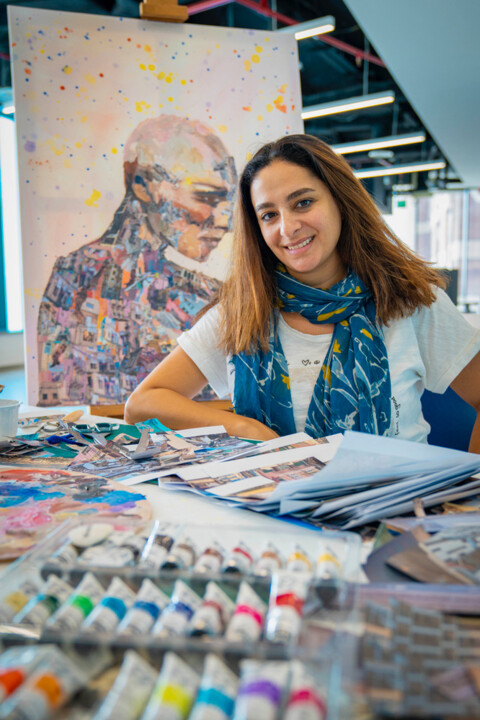

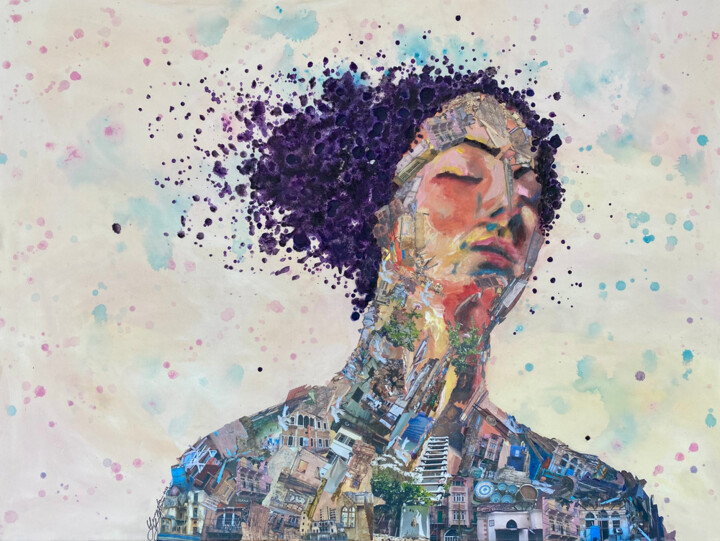



 Olimpia Gaia Martinelli
Olimpia Gaia Martinelli
